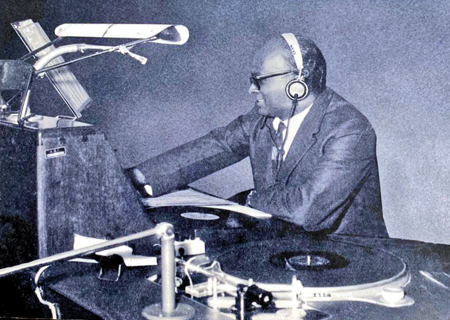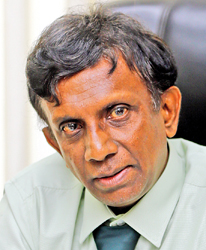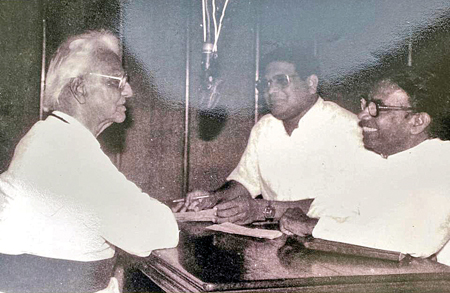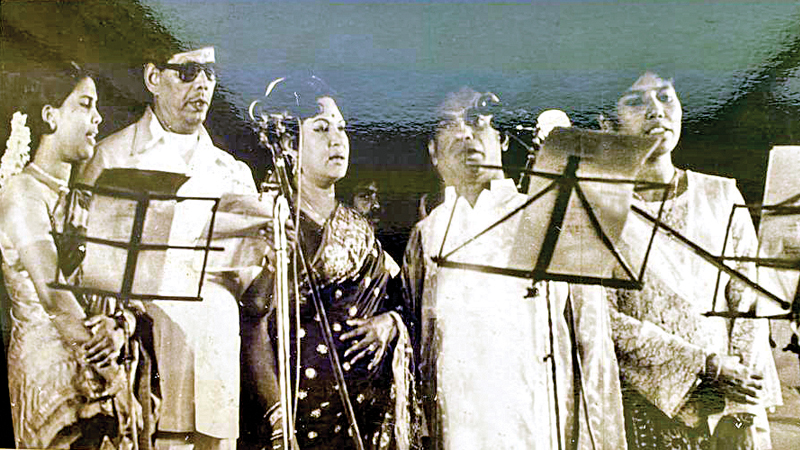 Radio is still one of the greatest means of communication, particularly for those living in the rural areas. It is a trustworthy source of information for people worldwide. Since radios are inexpensive and broadcasts can reach a large audience and low-income groups immensely benefit being exposed to this type of communication. Radio stations of course play a crucial role when it comes to disseminating news and educational content.
Radio is still one of the greatest means of communication, particularly for those living in the rural areas. It is a trustworthy source of information for people worldwide. Since radios are inexpensive and broadcasts can reach a large audience and low-income groups immensely benefit being exposed to this type of communication. Radio stations of course play a crucial role when it comes to disseminating news and educational content.
Despite the difficulties posed by the crises in recent years, the Sri Lanka Broadcasting Corporation (SLBC) has always been at the forefront of producing programs to uplift the mood of the people. The SLBC’s long-term national mission earned it the title of the Nation’s Communicator. Listeners will always remember the SLBC’s priceless contribution – be it information or entertainment over its 99- years in existence. December 16 will be a great day for the nation’s communicator – Asia’s first radio station when it marks its 99th anniversary. A special commemorative stamp valued at Rs. 50 will be issued to celebrate the occasion.
Radio SEAC

Sarath Wimalaweera presenting a program
As the first radio station in Asia, the SLBC officially began broadcasting on December 16, 1925. It was set up and renamed Radio SEAC (South East Asian Command) by the British military during World War II and continued to broadcast throughout South Asia until 1994. The fact that Sri Lanka (then known as Ceylon) launched its services just three years after broadcasting commenced in Europe, is itself a huge accomplishment. The station was returned to the Government after the War and on October 1, 1949 and renamed Ceylon Radio.
Radio Ceylon’s first Director General was John Lampson. Sir Hugh Clifford, the British Governor, completed his first broadcast and made his first public appearance on December 16, 1925. On April 1, 1962, M. J. Perera was appointed Radio Ceylon’s first local Director General. He put in writing the broadcasting ethics and thus made broadcasting history. Radio Ceylon was on the top slot among radio stations in South Asia and the market leader during his tenure.
The SLBC has many firsts and the first permanent commercial announcers were Prosper Fernando and Gunatunga K. Liyanage. Richard De Zoysa and Ravi John rose to prominence in English broadcasting in the 1980s. SLBC’s Sinhala announcers include Wimal Abesundara, Nanda Jayamanne, Cyril Rajapaksa and H.M. Gunasekara. Alongside Karunaratne Abesekara who was the first cricket commentator from Sri Lanka, Premasiri Epasinghe and Palitha Perera rose to prominence in the sports broadcasting sector.
Nevil Jayaweera, Thilak Gunaratne and S. Serasinghe are some of the nation’s few broadcasting developers. Radio Ceylon and the Department of Broadcasting were made as a State corporation on January 5, 1967 and were given the present name, the Sri Lankan Broadcasting Cooperation. Its Director General at the time was Nevil Jayaweera.
‘King of the Airwaves’
In the 1950s and the 1960s, Radio Ceylon had the privileged position of being the ‘King of the Airwaves’ in South Asia. The radio broadcasts reached millions of listeners throughout South Asia. The station also had a sizable audience in India. Radio Ceylon was at its height of popularity during this time. Clifford Dodd, an Australian administrator appointed under the Colombo Plan, founded the Commercial Service of Radio Ceylon on September 30, 1950. As its initial director, he helped the Commercial Service achieve great success.
Ven Palane Sri Vajiragnana Thera’s sermon was a significant Sinhala-language program which has been broadcast on this channel. Some of the best presenters and announcers in the world were produced by the SLBC and the then Radio Ceylon. Livy Wijemanne, Vernon Corea, Pearl Ondaatje, Greg Roskowski, Tim Horshington, Claude Selveratnam, Jimmy Bharucha, Thevis Guruge, Chitrananda Abesekara, A.W. Dharmapala, Karunaratne Abesekera, Premakeerthi de Alwis, H.M. Gunasekara, S.P. Mylvaganam, Gnanam Rathnam, Nihal Bharati, Leon Belleth and Vijaya Corea are the names that come to mind.

SLBC Chairman Uditha Gayashan. (Picture by Thilak Perera)
Radio Ceylon was a part of the Department of Broadcasting until 1967 when the Government changed it to a Corporation. Enrollment and announcer selection were carried out in a very open manner prior to this. Strict rules and regulations existed at that time and there was no partiality or political influence in those days, everything was clear cut. Broadcasters of the day had a free hand and could carry out their duties in a way that radio listeners would appreciate. K.H.J. Wijedasa and Vincent Panditha were two distinguished administrators who gave of their best to Sri Lanka’s broadcasting milieu.
In 1970, during Prime Minister Sirimavo Bandaranaike’s tenure, Susil Moonesinghe was the first political appointee appointed to the post of Director General of the SLBC. He was appointed by the Premier herself but later in 1972 she removed him from the post.
Since then, Governments in power have been responsible in making appointments to high posts. Despite this politicised backdrop, the SLBC had another successful broadcasting period from 1973 to 1977 under Director General R. Thilakeratne. He was an influential figure who transformed the country’s broadcasting history. This was a golden age for a new generation of singers, composers, and musicians, and he launched innovative programmes. During this time, the ‘Subavitha Geethaya’, ‘Muwan Palessa’ and ‘Lama Pitiya’ programmes were broadcast and became immensely popular among listeners. Many well-known composers, singers, musicians, and lyricists gained fame by participating in these shows.
A number of seasoned singers, composers and lyricists are among them, including Pandith Amaradewa, Nanda Malani, Ananda Samarakoon, Sunil Shantha, Narada Disasekara, Sunil Edirisinghe, Malani Bulathsinhala, Premasiri Kemadasa, Lionel Algama, Rohana Weerasinghe, Sunil SarathPerera, Sunil Ariyaratne and numerous others.
Among the most well-known commentators at the time were K.D.K. Dharmawardena, Palitha Perera, Mohan Samaranayake, Punya Lokuliyana, Bertie Galahitiyawa, Amarabandu Rupasinghe, Dalton de Alwis , and Ranjith Dharmakeerthi.

D.M. Colombage, the first Sinhala announcer to be appointed to
Radio Ceylon, presenting a program
The first edition of the Sinhala news bulletin was published by SLBC in 1974. Announcers were required to translate their own copy until that point. Health, Science, Entertainment, Youth and educational programs were among the many shows that the station broadcast and held listeners spellbound.
Bigger role
Speaking to the Sunday Observer on this historic milestone the present SLBC Chairman Dr. Uditha Gayashan said the media develops with technology. Media links communities, knowledge and subjective formations give the media the verve to carry on.
“However, as the national radio, we have a bigger role to play. We do not focus on just survival but also on cultivating society’s humanitarian aspect and the future. We also concentrate on creating a better tomorrow by following media ethics. This has always been our approach during the past century and will continue to be so in the next century as well,” he said.
He said media technology and literacy need to be shared with society. The national radio strives to inculcate decent and polite behaviour among listeners through its broadcasts.
“Media used to reach out to the common man. This was the practice in the days gone by but in recent years due to social change and changes the Institution has undergone in the recent past such practices have faded away. We need to rejuvenate these practices once again and revive the earlier feel and get close to the heartbeat of listeners,” he said.
Local radio is part of the country’s heritage as it can be traced several years back. The SLBC is very much like a library which has stored and preserved those years of history in its archives.
“The SLBC is undoubtedly a national treasure in this light as it has safeguarded some historic milestones. Our theme for this anniversary is ‘A New Approach to the Century of Radio Broadcasting’. Therefore, we will launch all our programs targeting our centennial with our 99th anniversary,” he said.

Fr. Marcelline Jayakody, Hudson Samarasinghe and K.B. Sugathdasa
in a discussion at the studio
The SLBC has produced many programs that draw at the heart strings of listeners and thus holds a special place. Despite many commercial obstacles, it continues to serve the public following a golden age of broadcasting. The National Radio has been instrumental in more ways than one in transforming communities from all walks of life.
The SLBC is to become the nation’s beacon in the communications firmament by effectively managing technology and production and changing the competitive conditions that the communications industry faces at present. It will surely be a glorious imprint for communication in the days to come.
With broadcasts in Sinhala, Tamil, and English that reach the entire island, SLBC is currently the top media outlet in Sri Lanka.
The residents of the island’s more isolated regions are served by its Kothmale, Dambana Radio, and Uva community radio stations. Broadcasting has changed with the times in the digital age, adopting streaming services and online platforms. Its reach has been further expanded by this evolution, making it possible for audiences around the world to engage with Sri Lanka’s rich cultural heritage and varied content.









